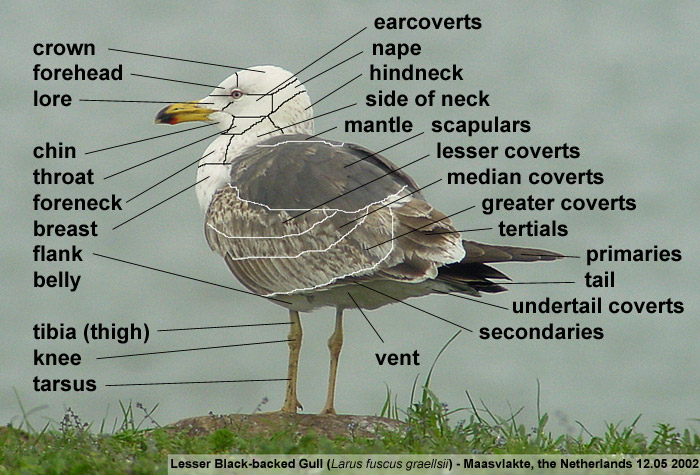 Gull
Topography - about remiges & scapular coverts...
Gull
Topography - about remiges & scapular coverts...
(last update: 10 oktober 2005)
Herring Gull argentatus
Herring Gull argenteus
Herring Gull smithsonianus
Great
Black-backed Gull marinus
Lesser B-b Gull
graellsii / intermedius
Lesser B-b Gull
fuscus
Yellow-legged
Gull michahellis
Yellow-legged
Gull atlantis
Caspian Gull cachinnans
Armenian Gull
armenicus
Baraba Gull barabensis
Heuglini's Gull
heuglini
Vega Gull
vegae
Mongolian Gull
mongolicus
Slaty-backed
Gull
schistisagus
.
Black-headed
Gull ridibundus
Grey-headed
Gull cirrocephalus
Brown-headed Gull
brunnicephalus
Bonaparte's
Gull philadelphia
Little Gull minutus
Mediterranean
Gull melanocephalus
Relict Gull relictus
Audouin's Gull audouinii
Slender-billed
Gull genei
Common / Mew
Gull canus
Ring-billed
Gull delawarensis
Franklin's Gull
pipixcan
Laughing Gull atricilla
Kittiwake Rissa
tridactyla
Ivory Gull Pagophila
eburnea
Ross's Gull Rodosthetia
rosea
Sabine's
Gull sabini
Great
Black-headed Gull ichtyaetus
Sooty Gull hemprichii
White-eyed Gull leucophthalmus
Glaucous
Gull hyperboreus
Iceland Gull glaucoides
Thayer's Gull thayeri
Kumlien's
Gull kumlieni
.
Mystery Gulls
Skua's Catharacta
/ Stercorarius
Terns Sterna
Other
Birds & Mammals
.
Home
Links
to Gullsites
Gull taxa
Gull Topography
Grey & Colour Charts
Locations in NW Europe
Summaries of Articles
About ORG
@

Moult
Normally, during summer and autumn, gulls
in the Netherlands moult the body feathers, tail feathers (rectrices)
and flight feathers. The flight feathers (remiges) can be divided in two
groups: secondaries and primaries. The primaries are moulted and
numbered in descendant order (from body towards wing-tip), while the
secondaries are moulted and numbered in ascendant order (from the
outermost secondary to the innermost secondary). For convenience, we have
treated the tertials as a separate group from the secondaries.
Duration of moult depends on species and may take up to 6 months.
In recent years, the study of moult score and moult strategy has increased. It is believed for instance that separating Lesser Black-backed Gull L.f.graellsii and L.f.intermedius from Baltic Gull L. f. fuscus should mainly be based on moult scores. The scores of moult of flight feathers is: score 0 for an old feather, score 1 for a lost or just growing new feather, score 2 when a feather is at one quarter, score 3 when a feather is at half of the length, score 4 at three-quarter, and score 5 when a feather is fully grown, lacking the waxy sheath. From April-July (start) to September-December (completion) the score increases from 0 to 50 in any single wing. Nevertheless, detailed descriptions remain necessary (and often mentioned at these pages) when moult is arrested, or strategies are complex and odd (e.g. P1-P5 new, P6-P7 old, P8-P10 new). Immature gulls start (and finish) the moult at an earlier date than adults.
In the picture below, a 2cy Yellow-legged Gull, show the main upper-part feathers. Note that the coverts are counted outwards: g1 being the innermost greater covert #1 and g15 being the 15th greater covert, often the last seen in a folded wing. The tertials are counted downwards: t1 to t6 where-after the merge into the secondaries. In the top picture, it can be seen that e.g. the scapulars are a relative large region of feathers. Therefore we use in the field a subdivision: upper scapulars and lower scapulars. Within the group of lower scapulars, three bars can be seen, upper lower scapulars, central lower scapulars and lower lower scapulars. And again, these can be divided in two groups: the inner and outer feathers. This makes exact allocation possible of single feathers. Note the second generation primaries with rounded tips.


Moult score (2cy in July): P1 halfway, P2 just visible, P3-P4 missing, P5-P10 old, primary moult score (PMS) = 7. |

Moult score (adult intermedius in November): P1-P8 new, P9 growing at 25% and P10 missing, score is 42. |
Remiges and
rectrices in LBBG (Lesser Black-backed Gulls)
Here you find some examples of different generation flight-feathers (remiges)
and tail-feathers (rectrices). Click the
thumbnails to go the linked pages with full-screen images.








